
Saturday. My first day completely free. Displaying
possibilities, and after consultation with Mr. National Geographic (see first picture you posted), I decided to approach to Himeji-jo, the most important castle in Japan. And what of "more important" because it is the only country that remains of as it was built, then here are not the stone as Albacete and Teruel, but of wood. And of course, then come the bad (mean by "bad" to the samurai, the Chinese or the Americans in World War II) and burn and run out of original castles. With what we all are restorations or copies, as this is the only original remains. This in the city of Himeji, where it takes its name. The de-jo means "castle." That is, to say Himeji-jo is the same as "Himeji Castle" (This does not happen in English, for example, and say "Juan" is not the same as "Castillo John ")
The trip is short and comfortable. Sannomiya underground and from there to a small train. Some day, if I remember, I will tell you here the railway lines mess around here. The fact is that I managed to get no problem to the city of Himeji is as urban as any other I've been finding since I've been here. Japan is a country that, as architecturally is concerned, only retains its ancient flavor as earthquakes, fires and bombs (nuclear and others) have ensured that nothing was left. Osaka, for example, is the third city in Japan (others say it is the second by the official second-Yokohama-Tokyo is so close that appear to be a unique and vast megalopolis) and has no nothing to visit besides Blade Runner type streets. In fact, Himeji-jo is still standing because it was never attacked by any enemy. Anyway ...
We went because I appeared in Himeji. The tourist office in the same season, serve me in English though I ask them anything (no merit because I have a lot of face Nippon know, but I assure you that not all sites do) and I leave so happy with my completely level, in which it was said that the castle is a 15 minute walk, but I a leisurely pace as I have done in less than ten. Not if you have been measured with Japanese way, which is like three quarters shorter than mine.
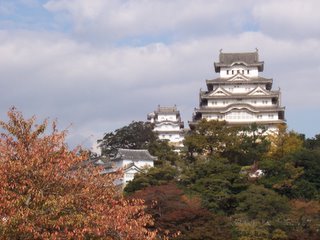 All modern city is built around the castle, to the point that since it leaves a wide avenue station (the largest of all Himeji) delivered in a straight line to the castle. And once you get to campus and there is no doubt that this place was the first monument that declared Unesco World Heritage Site in Japan. Himeji-jo, also called "White Heron Castle" because the shape of their roofs look like the wings of a heron flying, began to be built in the fourteenth century as a simple three-story castle until, in successive periods was heightened up to the seven it has now. It says it worked in about fifty million people (imagine that over several centuries, because if they had not sunk this part of the island) and, frankly, did well in their little job.
All modern city is built around the castle, to the point that since it leaves a wide avenue station (the largest of all Himeji) delivered in a straight line to the castle. And once you get to campus and there is no doubt that this place was the first monument that declared Unesco World Heritage Site in Japan. Himeji-jo, also called "White Heron Castle" because the shape of their roofs look like the wings of a heron flying, began to be built in the fourteenth century as a simple three-story castle until, in successive periods was heightened up to the seven it has now. It says it worked in about fifty million people (imagine that over several centuries, because if they had not sunk this part of the island) and, frankly, did well in their little job. 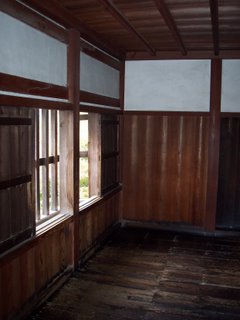 The museum has several gardens, the main tower and two smaller towers. There are signs indicating where to go, suggesting two possibilities: either the full tour or directly to the main tower. I, as a professional foreigner, I grab my camera and start taking pictures left and right looking for a thousand and one to which more innovative approaches. Some have been looking, for example, that to me leaning on the railing trying to shoot a roof gutter. In fact, I'm thinking about talking to the Traveler's Guide and I earn a bonus. What you see now on the left is one of the endless halls of the small tower where the princess lived Sen (married with Tadatoki Honda), who is said never left the castle while he lived in it. Are preserved drawings of the princess and her daily life, and from these drawings have been recreated in one room (the only room that was decorated in the castle at the time) as would the daily life of Princess Sen.
The museum has several gardens, the main tower and two smaller towers. There are signs indicating where to go, suggesting two possibilities: either the full tour or directly to the main tower. I, as a professional foreigner, I grab my camera and start taking pictures left and right looking for a thousand and one to which more innovative approaches. Some have been looking, for example, that to me leaning on the railing trying to shoot a roof gutter. In fact, I'm thinking about talking to the Traveler's Guide and I earn a bonus. What you see now on the left is one of the endless halls of the small tower where the princess lived Sen (married with Tadatoki Honda), who is said never left the castle while he lived in it. Are preserved drawings of the princess and her daily life, and from these drawings have been recreated in one room (the only room that was decorated in the castle at the time) as would the daily life of Princess Sen. 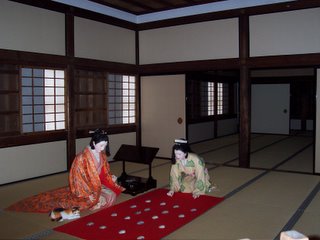 The picture looks a little for tourists, but I live faith that impresses. The mannequins are made, and helps a lot to the conservation of the building descalzarte obligation to enter (you get a zapatillitas and a plastic bag for you to put your shoes).
The picture looks a little for tourists, but I live faith that impresses. The mannequins are made, and helps a lot to the conservation of the building descalzarte obligation to enter (you get a zapatillitas and a plastic bag for you to put your shoes). From what I read on the posters, not just a house but has the mission of strength as we understand it, that is, that besides the feudal lord and his warriors and peasants would live also at your service. This is so immense and Japan have so little land that had it not been so serious a nerve by Norimura Akamatsu, founder of the castle. I hope you do not believe that I remember memory of names: I'm reading the folletillo given to me at the door. I have enough fight in the coconut to save the little phrase that means "Can you take a picture, please?" to go learn the name of the shogun.
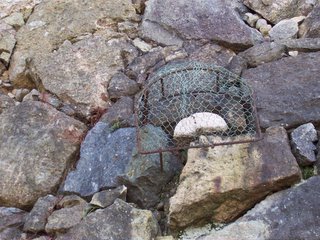 Two have been special moments in Himeji-jo in which I began to mourn as a cockatoo weeping, though the picture on the left you either look like a landmark, a of those times was to read the history of this stone, when in the fifteenth century it was fortified stone castle, the lord of the day he met with the serious problem of the scarcity of stone. A few miles in some poky old town belonging to the Lord, lived a poor old woman whose only income were those who managed to sell rice cakes made by her. Knowing that his master was in trouble, went the distance to offer the only thing I had: the stone with hand grinding rice. Hashiba, M., was deeply moved by the story and ordered that the grinding stone is placed in a transit preferential everyone could see it. The story does not say whether the reward with something or not, but I guess so.
Two have been special moments in Himeji-jo in which I began to mourn as a cockatoo weeping, though the picture on the left you either look like a landmark, a of those times was to read the history of this stone, when in the fifteenth century it was fortified stone castle, the lord of the day he met with the serious problem of the scarcity of stone. A few miles in some poky old town belonging to the Lord, lived a poor old woman whose only income were those who managed to sell rice cakes made by her. Knowing that his master was in trouble, went the distance to offer the only thing I had: the stone with hand grinding rice. Hashiba, M., was deeply moved by the story and ordered that the grinding stone is placed in a transit preferential everyone could see it. The story does not say whether the reward with something or not, but I guess so.  The other touching moment of the day has been five minutes later, when I finally reached the esplanade of the main tower. Sitting on a bench, I got my book of Japanese classical poetry (Kokinwakashu) and I randomly selected a poem to read in any environment, which, in my opinion, was the most appropriate. The poem was:
The other touching moment of the day has been five minutes later, when I finally reached the esplanade of the main tower. Sitting on a bench, I got my book of Japanese classical poetry (Kokinwakashu) and I randomly selected a poem to read in any environment, which, in my opinion, was the most appropriate. The poem was: thought that drops of dew
were ephemeral?
Just because I do not I lay on the grass.
Koremoto Fujiwara no, its author, wrote shortly before his death.
Perhaps under normal circumstances would have seemed only a bit sweet, sweet ... but here all I have another color, as I will tell you shortly. I am more receptive to affection, emotions, a poor old woman out of work to help his master and a ninth-century Japanese poet who understands, finally, that life is the best thing that has been given. Cry, therefore, without any complex, I put some music (the soundtrack to The Empire of the Sun is more Japanese than I have so far in the iPod), consider the facade that I now share with you, breathe in peace; no hurry, I headed up the seven floors of the main tower of Himeji-jo.
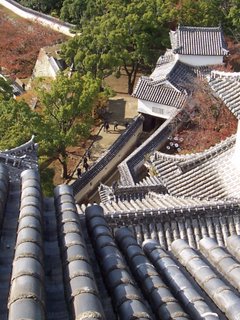 is very striking is the absence of decoration in the rooms of the castle. On the walls are only are the poles on which hung the weapons are spears, katanas or other contraption. They are, as I said, sweeping seven floors. Obviously there is no elevator, and fatigue is taking over one. At the top the landscape startles. There are, of course, a small altar with some bells as Minatogawa. The people, very devoted, take coins and asked their wishes (or what you do, you do not know). Died of cold at altitude, I turned and walked to home.
is very striking is the absence of decoration in the rooms of the castle. On the walls are only are the poles on which hung the weapons are spears, katanas or other contraption. They are, as I said, sweeping seven floors. Obviously there is no elevator, and fatigue is taking over one. At the top the landscape startles. There are, of course, a small altar with some bells as Minatogawa. The people, very devoted, take coins and asked their wishes (or what you do, you do not know). Died of cold at altitude, I turned and walked to home. I hope you understand that is so different for me that I can not describe in detail everything that catches my attention: would spend so much time writing as seeing things, and I could not run a play, which is what I have come. That's why that from now on, try to be more concise on the spot. Himeji-jo, anyway, this post was worth so long on the blog.
By the way, if you want more information about Himeji-jo, I suggest you enter on this page:
http://web-japan.org/nipponia/nipponia17/es/feature/feature03.html Now I
leave. In a little more. Although not if better.
0 comments:
Post a Comment